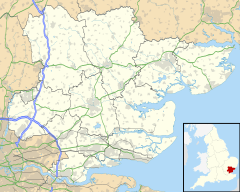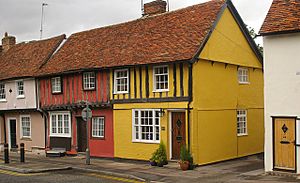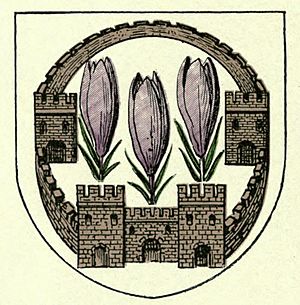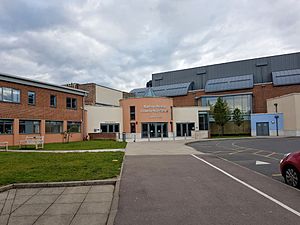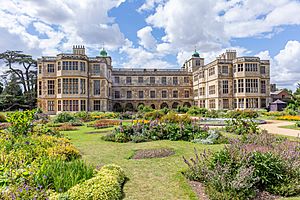Saffron Walden facts for kids
Quick facts for kids Saffron Walden |
|
|---|---|
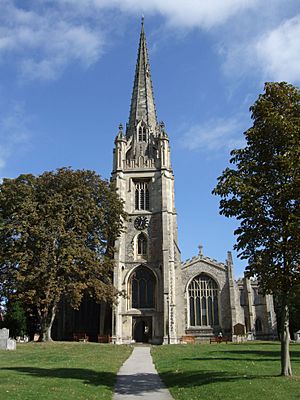 St Mary the Virgin, Saffron Walden |
|
| Population | 16,613 (2021 census) |
| OS grid reference | TL541387 |
| Civil parish |
|
| District |
|
| Shire county | |
| Region | |
| Country | England |
| Sovereign state | United Kingdom |
| Post town | SAFFRON WALDEN |
| Postcode district | CB10, CB11 |
| Dialling code | 01799 |
| Police | Essex |
| Fire | Essex |
| Ambulance | East of England |
| EU Parliament | East of England |
| UK Parliament |
|
Saffron Walden is a historic market town in Essex, England. It is about 12 miles (19 km) north of Bishop's Stortford. The town is also 15 miles (24 km) south of Cambridge and 43 miles (69 km) north of London. Saffron Walden still looks very rural. Many of its buildings are from the medieval period. In 2021, about 16,613 people lived there.
Contents
A Look Back: Saffron Walden's History
Archaeologists believe people have lived in or near Saffron Walden for a very long time. This goes back to the Stone Age. A small Roman settlement and fort might have been here too. It was likely an outpost of a larger Roman town nearby.
From Norman Times to a Market Town
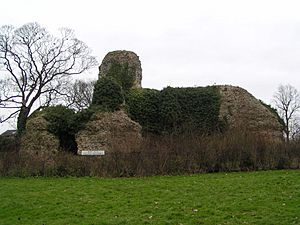
After the Normans conquered England in 1066, a stone church was built. Walden Castle was built around 1140. It might have used older forts already there. A priory, which is a type of monastery, was started around 1136. This was on the site of what is now Audley End House. After monasteries were closed down, Sir Thomas Audley changed the priory buildings into a home. This later became the grand Audley End House.
The town's market moved from nearby Newport to Walden. This made Walden more important. The market started in 1295. The town got its first official charter around 1300. Back then, it was called Chepyng (which means Market) Walden. The town grew from around the castle to include a larger area to the south. The main market square became the heart of the town.
In medieval times, wool was the main product traded. A special building for wool traders was in the market square. It was taken down in 1847 to build the Corn Exchange.
Why "Saffron"? The Story of a Flower
In the 1500s and 1600s, the saffron crocus flower was grown a lot here. The town's soil and weather were perfect for it. The red parts of the flower were used for many things. These included medicines, cooking, perfume, and as a valuable yellow dye. This industry gave Walden its current name. By the 1540s, the town was known as Saffron Walden.
Puritans, Quakers, and the Civil War
In the 1600s, Saffron Walden was a strong Puritan town. Many people here were Puritans. Some families even moved to America during this time.
During the English Civil War, Saffron Walden was important. It was the headquarters for the New Model Army. Oliver Cromwell, a famous leader, visited the town in 1647. He stayed for 19 days.
By the late 1700s, saffron was not popular anymore. The town then started trading in malt and barley. Many malt houses were built. Even though this trade was not as rich as saffron, the town kept growing. In the 1800s, Quakers became very active in the town's economy. The Gibson family, who helped start Barclays Bank, helped build many public buildings. These include the Saffron Walden Museum and the Saffron Walden Town Hall.
In the 1900s, a railway line connected Saffron Walden to the main line. This line was later closed in the 1960s. After World War II, big factories came to the town. Acrows Ltd, which made building equipment, became a major employer.
Town Symbols: Coat of Arms and Maces
Saffron Walden has an unofficial coat of arms. It shows the saffron crocus flower inside castle walls. This is a clever play on words: "Saffron walled-in." In 1961, the town got a formal coat of arms.
The town also has three special ceremonial staffs called ceremonial maces. The largest one was given by King James II in 1685. Two smaller silver maces were bought in 1549. This was to celebrate a new town charter from King Edward VI.
Places to See and Explore
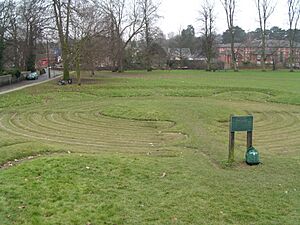
The old Walden Castle from the 12th century is now in ruins. People used its stones to build local houses. All that is left is the ruined basement.
Near the castle is a turf maze. This is a large pattern cut into the grass. It is the biggest turf maze in England. It is about 100 feet (30 meters) wide. It has been fixed up many times over the years.
The oldest building where people still live is thought to be 1 Myddleton Place. This 15th-century building used to be a youth hostel. Now it is used for events. Other old buildings can be found on Bridge Street and Castle Street.
Bridge End Gardens are seven gardens linked together. They include a maze, a rose garden, and a walled garden. The Gibson family first created them around 1840. They have been restored with help from volunteers.
St Mary the Virgin, Saffron Walden is the biggest parish church in Essex. The church was mostly rebuilt in the late 1400s. Its tall spire was added in 1832. The church is 183 feet (56 meters) long. Its spire is 193 feet (59 meters) high, making it the tallest in Essex.
Saffron Walden also has a Catholic church, Our Lady of Compassion. It was made from a 16th-century barn in 1906. The town has a long history of other Christian churches too. These include a Baptist church, a Quaker meeting house, a United Reformed Church, and a Methodist church.
Education and Learning
Saffron Walden County High School is a large school for both boys and girls. It has over 2000 students. It is located west of the town center. Inspectors rated it as "outstanding" in 2012.
This school replaced the old Saffron Walden Grammar School. That school was started in 1521 by the town's Holy Trinity Guild. Dame Joan Bradbury, a local helper, also founded Dame Bradbury's School.
Friends' School, later called Walden School, was a Quaker independent school. It closed in 2017.
Getting Around: Transport
Trains and Buses
The closest train station to Saffron Walden is Audley End. It is about 2 miles (3.2 km) outside the town. Buses regularly connect the station to the town center. Trains from Audley End go to Cambridge and London Liverpool Street. You can get to London in about 55 minutes.
Regular bus services connect Saffron Walden to other towns. These include Cambridge, Bishop's Stortford, and Stansted Airport.
Roads and Air Travel
You can reach Saffron Walden from the M11 motorway. During the coronavirus pandemic, some roads in the town center were made narrower. This was to help people keep a safe distance. Some speed limits were also lowered to 20 mph (32 km/h).
Stansted Airport is about 15 miles (24 km) from the town. Luton Airport is 43 miles (69 km) away. There is also a small private airfield near the town.
Fun Things to Do: Culture and Leisure
Audley End House is a huge old mansion. It is now looked after by English Heritage. You can visit it and explore its history. In summer, concerts are sometimes held in its gardens. The Audley End Miniature Railway is a fun train ride. It goes through the woods next to Audley End House.
Saffron Walden Museum was started in 1835. It is near the town's castle. The museum has many interesting things. These include a stuffed lion named Wallace. It also has the mummy of a 7-year-old from ancient times.
The Fry Art Gallery shows art by artists linked to Saffron Walden. It has many works by Edward Bawden and Eric Ravilious.
Saffron Hall is a concert venue at Saffron Walden County High School. It opened in 2013. It can seat 730 people. It was built thanks to a large donation from someone who loves music.
Saffron Walden Market is a busy market. Local sellers offer many goods. It is held every Tuesday and Saturday.
Sports and Activities
The Anglo American playing fields are home to the town's cricket club. They were given to the town by American forces after World War II. A monument there remembers American airmen and local people who died in the war.
- Saffron Walden has a football club called Saffron Walden Town F.C.. They play at Catons Lane.
- There is also a rugby club.
- A team for long-distance running and triathlon.
Lord Butler Leisure Centre has a pool, gym, and sports injury clinic.
The Tour de France cycling race passed through Saffron Walden in 2014.
Saffron Walden has a strong hockey club. They have many men's, women's, and junior teams.
The town's skate park opened in 2007. It was built by an American company.
Music and Media
"Saffron Walden" is the name of a tune often used for the hymn "Just as I Am". It was written by Arthur Henry Brown from Essex. He named many of his hymn tunes after places he liked.
Local news and TV shows come from BBC East and ITV Anglia. The town has two local newspapers: the Saffron Walden Reporter and Walden Local.
Famous People from Saffron Walden
- Edward Bawden (1903–1989), an artist.
- Stig Blomqvist (born 1946) and his son Tom Blomqvist (born 1993), racing drivers.
- Rab Butler (1902–1982), a government minister and former Member of Parliament for Saffron Walden.
- Jack Cardiff (1914–2009), an Oscar-winning filmmaker.
- Charles Dunstone (born 1964), who helped start Carphone Warehouse.
- Imogen Heap (born 1977), a singer and songwriter.
- Jeff Hordley (born 1970), an actor known for Emmerdale.
- Ian Lavender (1946–2024), an actor from Dad's Army.
- Jojo Moyes (born 1969), a romantic fiction author.
- Cliff Parisi (born 1960), an actor from EastEnders.
- Tom Robinson (born 1950), a singer-songwriter.
- Sir Thomas Smith (1513–1577), a scholar and diplomat.
- Henry Winstanley (1644–1703), who built the first Eddystone Lighthouse.
- Diana Wynne Jones (1934–2011), an author.
Sister Town
Saffron Walden is twinned with Bad Wildungen in Germany.
Images for kids
See also
 In Spanish: Saffron Walden para niños
In Spanish: Saffron Walden para niños


